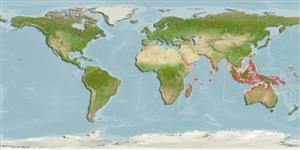Bivalvia |
Mytilida |
Mytilidae
Environment: milieu / climate zone / depth range / distribution range
Ecology
Benthic. Tropical
Indo-West Pacific: from northwest Indian Ocean, including the Red Sea, to Indonesia; north to Vietnam and south to New Caledonia. Exact distribution of this species is not known, because of confusions with other related mytilid species.
Length at first maturity / Size / Weight / Age
Maturity: Lm ? range ? - ? cm Max length : 5.0 cm TL male/unsexed; (Ref. 348); common length : 3.0 cm TL male/unsexed; (Ref. 348); max. reported age: 2.00 years (Ref. 8702)
Shell rather small, thin and fragile, somewhat translucent, roughly elongate trapeziform in outline, with very long and rather narrow shape. Anterior margin of valves quite short and sharply rounded, clearly extending forwards beyond the umbones. Ventral margin very long and broadly concave medially. A broad and rounded keel, radiating obliquely towards posteroventral end of valves and bordered anteriorly by a wide and shallow depression determining the sinuation of ventral margin. Outer surface of valves smoothish with only fine concentric growth lines and a few small radial grooves in front of the umbones. Periostracum smooth and shiny, translucent, closely applied to shell surface. Hinge line with very small crenulations, mainly appearing behind the ligamental margin. Anterior adductor scar present. Internal margins very thin and smooth, undulate anteriorly in relation to the outer radial sculpture. Colour: outer coloration variable, light tan to olive-green or brown, often paler on the keel, with a median radial band and sometimes irregular transverse stripes of purplish brown on posterodorsal slope. Interior slightly pearly, pale bluish grey with the outer colour pattern showing through.
On soft bottoms, often occurring gregariously. Intertidal and shallow subtidal waters (Ref. 348).
Life cycle and mating behavior
Maturity | Reproduction | Spawning | Eggs | Fecundity | Larvae
Members of the class Bivalvia are mostly gonochoric, some are protandric hermaphrodites. Life cycle: Embryos develop into free-swimming trocophore larvae, succeeded by the bivalve veliger, resembling a miniature clam.
Poutiers, J.M. 1998 Bivalves. Acephala, Lamellibranchia, Pelecypoda. p. 123-362. In Carpenter, K. E. and V. H. Niem. 1998. FAO species identification guide for fishery purposes. The living marine resources of the Western Central Pacific. Volume 1. Seaweeds, corals, bivalves, and gastropods. Rome, FAO. (Ref. 348)
IUCN Red List Status
(Ref. 130435: Version 2025-1)
CITES status (Ref. 108899)
Not Evaluated
Not Evaluated
Threat to humans
Harmless
Human uses
| FishSource |
Tools
More information
Trophic EcologyFood items (preys)
Diet composition
Food consumption
Predators
Life cycleReproductionMaturityFecunditySpawningEggsEgg developmentLarvae PhysiologyOxygen consumption
Human RelatedStamps, coins, misc.
Internet sources
Estimates based on models
Preferred temperature
(Ref.
115969): 27.1 - 29.3, mean 28.7 (based on 1810 cells).
Resilience
High, minimum population doubling time less than 15 months (K=1.2; tmax=2).
Fishing Vulnerability
Low vulnerability (10 of 100).
